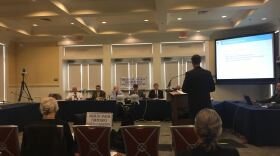A proposed settlement agreement has been reached regarding the decommissioning of the Central Coast’s Diablo Canyon nuclear power plant.
The agreement is between several groups—including San Luis Obispo County, the Alliance for Nuclear Responsibility, the Utility Reform Network—and plant owner Pacific Gas & Electric (PG&E). It’s part of PG&E's current application before state regulators determining how much it will cost the company—and ratepayers—to shut down the 34-year-old plant, California’s last operating nuclear power plant.
The agreement details a cost of almost a billion dollars less than the company initially asked for to cover the costs of decommissioning. PG&E had requested $4.8 billion dollars, but the settlement agrees to $3.9 billion dollars.
The settlement also speeds up the removal of spent nuclear fuel from cooling pools to safer dry casks. Instead of taking up to ten years to do so, PG&E has agreed to a four-year timeline.
Alex Karlin, a former Nuclear Regulatory Commission judge and current member of the Diablo Canyon Decommissioning Engagement Panel, said the sooner the better.
“The single greatest thing that PG&E can do—short of shutting down the plant tomorrow—to reduce the radiological risk associated with Diablo Canyon, would be to commit to moving the spent fuel from the spent fuel pools and putting it into dry casks as soon as possible,” Karlin told KCBX News Friday.

Karlin also pointed out a portion of the agreement that details a savings of $400 million by PG&E leaving the breakwater constructed with the plant was built over several years in the late 1960s and early 1970s, rather than spending that money to remove and dispose of the breakwater.
That’s if federal and state regulators allow the breakwater to stay and be ‘repurposed.’ A formal joint motion for adoption of the settlement agreement was filed Friday with the California Public Utilities Commission, and a commission administrative law judge and the commission itself will decide if the settlement is ‘reasonable as a whole,’ and in the public interest.






